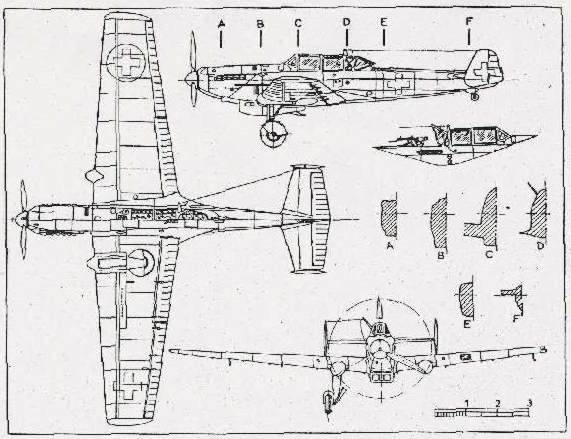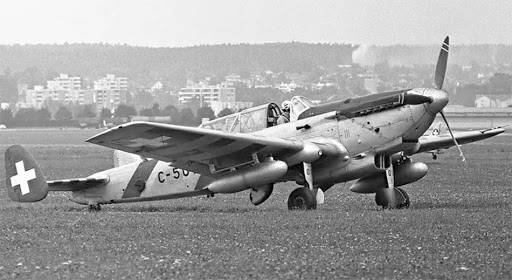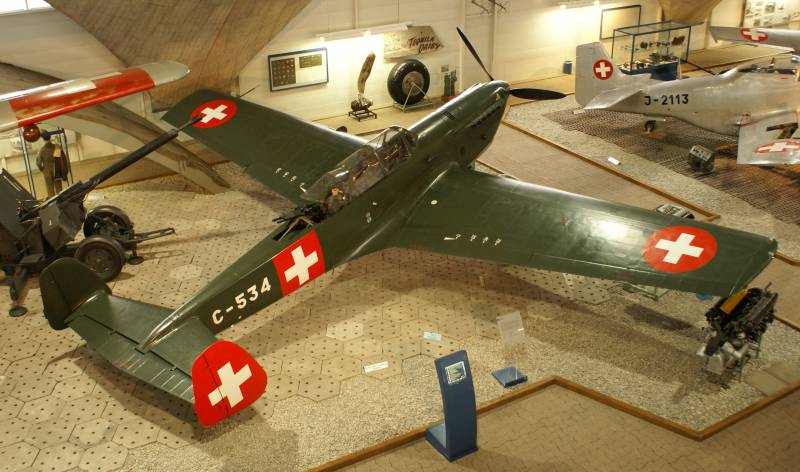Alpine Meadow Plane
In the second half of the thirties of the last century, the countries of the world frantically armed, realizing that another war was just around the corner. They also realized this in the prosperous and long-declared neutrality of Switzerland. Negotiations were held on the supply of new aircraft with France and Germany. The Germans provided Bf-109, the French - MS-406. The position of the heavy fighter / light bomber remained open. At first, the French seemed to have pledged supplies and a license for the Potez 630. But something did not grow together. Then it was decided to manufacture its own combat vehicle. According to the then fashionable concept of a “flying cruiser”. So that he could carry out reconnaissance, and deliver a bomb assault strike, and drive away the enemy! History showed that these trends turned out to be erroneous. The Swiss were no exception.
Work on the creation of the aircraft was entrusted in 1936 to the company EKW, located in the canton of Bern. Design work progressed very slowly. When the threat of war became real, they replaced the project manager and improved funding.
In 1938, began to create the first model. They called it C-3601. The aircraft was a two-piece all-metal free low-wing with a two-keel plumage and fixed gear. The chassis, by the way, was covered with fairings like the Yu-87. The rudders and ailerons were covered with linen. The engine is a 12-cylinder Hispano-Suiza 12 Y-77 rated at 860 horsepower. The armament consisted of a 20-mm cannon mounted in the collapse of the cylinders, two 7,5 mm machine guns in the wing and one of the same for the letnab.
The first flight took place on May 15, 1939. Factory tests were successful, but during the military ... During the dive strong vibrations were revealed, both ailerons flew off, the car crashed. But the work was recognized as promising. We began to build the prototype S-3602. The design was strengthened. The engine was replaced with a more powerful one - at 1000 hp. The aircraft took off on November 30, 1939. They conducted satisfactory factory tests and even military ones. A contract was signed for the supply of 57 aircraft. True, the speed (440 km / h) did not suit the military. It was agreed that they would be able to raise it to the level of 470 km / h. They decided to make the landing gear retractable, and also strengthened the armament: instead of one machine gun, the rear hemisphere began to be covered by a spark, and under the wing eight suspension units for 400 kg bombs were placed.
The lead aircraft of the installation series took off in September 1941. And then all the “childhood diseases” of the new machine appeared. Alarms began to arrive from flying units about the occurrence of vibrations at high speeds. During additional tests, the wings of the aircraft fell off, the crew died ... An investigation showed that the flutter of the wing caused by rounded edges became the fault. The wing was "cut off", the area was reduced. Along the way, returned to one machine gun in the cabin of the letnab.
Back in 1941, the order for S-36 was increased to 200 aircraft, but in 1942 it was reduced to 150. Looking ahead, I’ll inform you that a total of 147 aircraft were assembled.
Meanwhile, EKW continued to improve the car. The next modification was already equipped with an engine in 1410 "horses". Wing machine guns were replaced with 20 mm guns, the bomb load was increased to 600 kg.
But all this was already belated. The prototype took off in 1944. And even showed a speed of 560 km / h. But the debugging of the aircraft was delayed, and a century was reactive on the threshold aviation...
In service with the S-36 stood until 1953. The main task was to patrol the borders. Only one combat collision is known for certain: in 1944 a pair of “Swiss” entered the battle with the “Mustang” that accompanied the American bombers. They got off with bullet holes. For the entire service of combat losses and victories, the aircraft did not gain. True, in flight accidents lost 11 cars.
It would seem that after the end of World War II, the S-36 could be forgotten. There it was! Zealous Swiss sent a part to the scrap, and newer vehicles began to be converted into combat training, glider tugboats, target tugboats and transport and rescue vehicles. Drop-down containers with food, fuel and medicines for victims of avalanches and snow drifts were attached to the bomb racks. And they served in this incarnation until they were replaced by helicopters in the early sixties!
It can be stated that the plane went below average. It was originally based on an erroneous concept, there was no experience in the construction of these machines, however, as well as operating experience. But do not forget that this was the first independent development of a non-aircraft building country! She gave an impetus to the industry and design experience.
At the moment, it is known about two museum pieces and a couple of flying ones (they are in private collections).
The performance characteristics of the S-3603:
Wingspan - 13,74 m.
Length - 10,23 m.
Height - 3,29 m.
Wing area - 28,4 square. m
Empty weight - 2315 kg.
Take-off weight - 4085 kg.
The maximum speed is 476 km per hour.
Rate of climb - 10, 4 m per second.
Ceiling - 8700 m.
Flight range - 680 km.
Flight duration - 2 hours.




Information